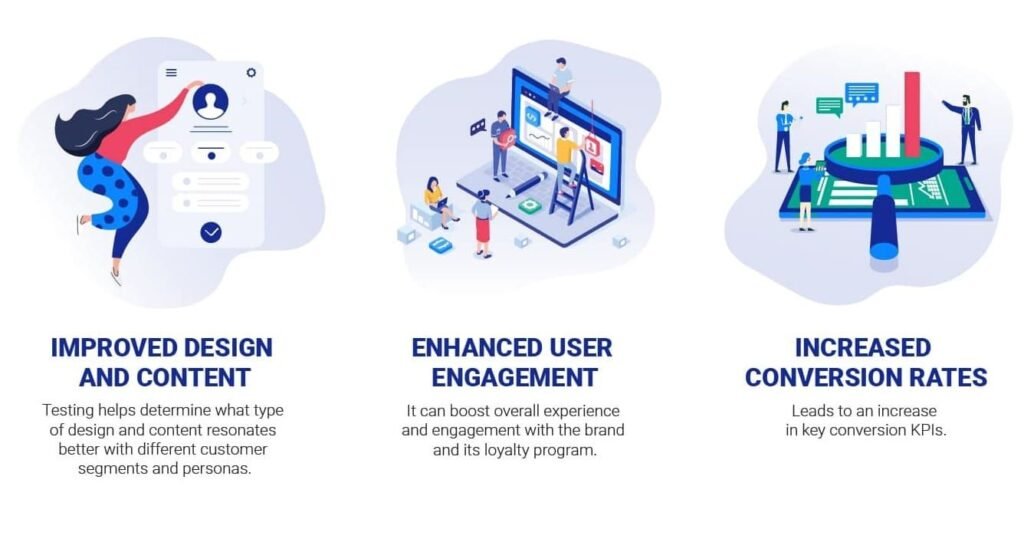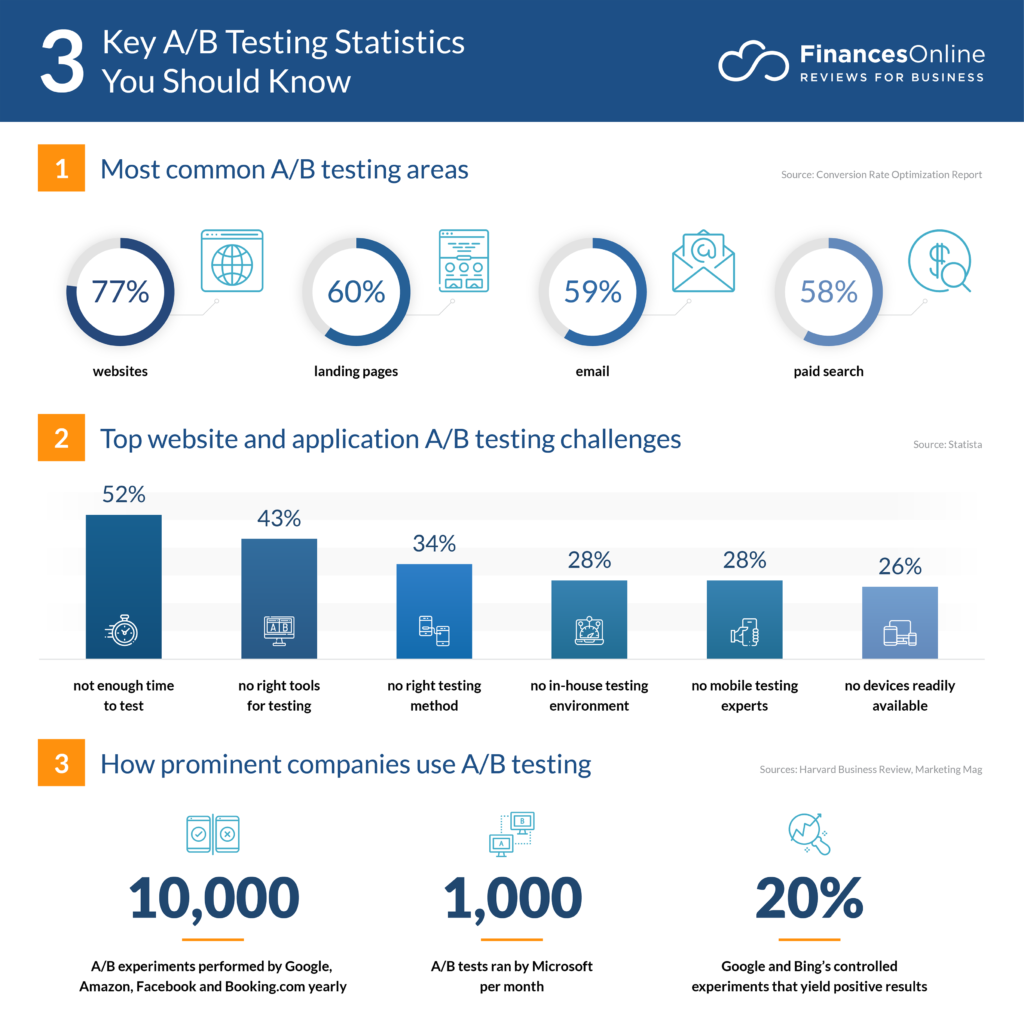The benefits of A/B testing for enhancing customer experience
Explore the benefits of A/B testing for improving conversion rates and optimizing your business strategy, with tips for effective testing.
KEY TAKEAWAYS
A/B testing is a powerful tool for businesses to optimize their marketing efforts and improve their online presence.
By comparing two versions of a webpage or marketing campaign, A/B testing allows businesses to identify which version performs better and make data-driven decisions.
A/B testing can help businesses increase website conversions, improve customer experience, and enhance user engagement.
A/B testing can also help businesses maximize their advertising spend by identifying which ads are most effective in driving conversions.
Making A/B testing a priority in your growth strategy can lead to higher ROI and greater business success.
In today’s digital age, businesses need to constantly optimize their marketing efforts to stay ahead of the competition. One effective way to do this is through A/B testing, a technique that compares two versions of a webpage or marketing campaign to identify which performs better. A/B testing can help businesses improve their conversion rate optimization, enhance customer experience, and make data-driven decisions to drive business success. By analyzing data from A/B tests, businesses can make informed decisions and tailor their marketing strategies to better meet the needs of their customers. In this article, we’ll explore the many benefits of A/B testing for business success and provide insights on how businesses can leverage this technique to maximize their marketing efforts. Whether you’re new to A/B testing or looking to enhance your current data analysis capabilities, this article will provide valuable insights to help you stay ahead of the curve.
Understanding A/B Testing
A/B testing, also known as split testing, is a technique used by businesses to compare two versions of a webpage or marketing campaign to identify which version performs better. The goal of A/B testing is to optimize conversion rate optimization (CRO) and make data-driven decisions to drive business success.
Definition and explanation of A/B testing
In A/B testing, two versions of a webpage or marketing campaign are created – the control version (version A) and the variation version (version B). The two versions are then shown to a group of users, with half of the group seeing version A and the other half seeing version B. The goal is to determine which version performs better in terms of engagement, click-through rates, and ultimately, conversions.
Types of A/B testing
There are several types of A/B testing that businesses can conduct, including:
- Landing page A/B testing: This involves testing two different versions of a landing page to determine which version leads to higher conversions.
- Email A/B testing: This involves testing two different versions of an email campaign to determine which version leads to higher open rates, click-through rates, and conversions.
- Call-to-action (CTA) A/B testing: This involves testing two different versions of a call-to-action button to determine which version leads to higher click-through rates.
Examples of A/B testing in real-world scenarios
A/B testing is widely used by businesses to optimize their marketing efforts and improve their online presence. For example:
Airbnb conducted A/B testing to determine which version of their website’s landing page led to higher conversions. By testing different images, headlines, and calls to action, they were able to increase their revenue by $30 million.
Dropbox conducted A/B testing to optimize its pricing page, resulting in a 10% increase in conversions.
HubSpot conducted A/B testing on their email campaigns and found that personalized subject lines led to a 29.56% increase in open rates.
Overall, A/B testing is a powerful tool that businesses can use to optimize their marketing efforts and improve their online presence. By conducting A/B tests, businesses can make data-driven decisions that lead to higher conversion rates and ultimately, greater business success.

Photo: Comarch
Benefits of A/B Testing for Business Success
A/B testing is a valuable technique that can help businesses improve their conversion rate optimization (CRO) and make data-driven decisions to drive business success. Let’s explore some of the key benefits of A/B testing:
- Improved conversion rates
One of the primary benefits of A/B testing is improved conversion rates. By testing different versions of a webpage or marketing campaign, businesses can identify which version performs better and make changes accordingly. This can lead to higher conversion rates, which ultimately results in more sales and revenue.
- Enhanced user experience
A/B testing can also help businesses enhance the user experience (UX) of their website or marketing campaigns. By testing different layouts, colors, and designs, businesses can determine which version resonates better with their target audience and leads to higher engagement and satisfaction.
- Increased customer engagement
A/B testing can also help businesses increase customer engagement. By testing different calls-to-action (CTAs), headlines, and messaging, businesses can identify which version leads to higher click-through rates and engagement with their audience.
- Higher revenue and profits
A/B testing can lead to higher revenue and profits for businesses. By optimizing their conversion rates, enhancing user experience, and increasing customer engagement, businesses can generate more sales and revenue.
- Better decision-making
A/B testing provides businesses with valuable data that can inform better decision-making. By analyzing the results of A/B tests, businesses can identify which versions of their webpage or marketing campaign perform better and make data-driven decisions to optimize their marketing efforts.

Photo: FinancesOnline
Competitive advantage
By leveraging the benefits of A/B testing, businesses can gain a competitive advantage in their industry. By constantly optimizing their marketing efforts and making data-driven decisions, businesses can stay ahead of the curve and achieve greater success.
Overall, A/B testing is a powerful tool that can help businesses improve their conversion rates, enhance user experience, increase customer engagement, generate higher revenue and profits, make better decisions, and gain a competitive advantage. By making A/B testing a priority in their growth strategy, businesses can optimize their marketing efforts and achieve greater success.
Real-World Scenarios
A/B testing has become an increasingly popular technique for businesses looking to improve their conversion rates and achieve greater success. Let’s take a look at some real-world scenarios where A/B testing has been successful:
Case studies on successful A/B testing
Several businesses have achieved success through A/B testing. One example is Airbnb, which used A/B testing to improve the user experience of its website. By testing different versions of its website, Airbnb was able to increase the number of bookings by 30%. Another example is Dropbox, which used A/B testing to increase its conversion rates by 10%.
Examples of how A/B testing helped businesses in different industries
A/B testing has helped businesses in a variety of industries achieve success. For example, a clothing retailer used A/B testing to determine which colors and images were most effective in driving sales, resulting in a 34% increase in revenue. A healthcare company used A/B testing to improve its website’s user experience, resulting in a 22% increase in sign-ups for its service.
Challenges faced during A/B testing and how to overcome them
While A/B testing can be highly effective, there are also challenges that businesses may face. One common challenge is determining the appropriate sample size for the test. To overcome this challenge, businesses can use statistical tools to determine the necessary sample size for the test. Another challenge is determining which metrics to track during the test. To overcome this challenge, businesses should identify the most important metrics for their specific test and focus on tracking those.
Overall, A/B testing has proven to be a highly effective technique for businesses in a variety of industries. By using A/B testing to optimize their conversion rates, improve user experience, and increase customer engagement, businesses can achieve greater success. While there are challenges associated with A/B testing, businesses can overcome them by using statistical tools and focusing on the most important metrics for their specific test.
A/B Testing Best Practices
While A/B testing can be a powerful tool for businesses, it’s important to follow best practices to ensure accurate and effective results. Here are some best practices to keep in mind:
Tips for effective A/B testing
- Clearly define the goal of the test: Before starting a test, it’s important to have a clear understanding of what you hope to achieve. Are you looking to increase conversion rates, improve user experience, or something else?
- Test one variable at a time: To ensure accurate results, it’s important to test only one variable at a time. Testing multiple variables at once can make it difficult to determine which change led to the results.
- Use a large enough sample size: It’s important to use a large enough sample size to ensure that the results are statistically significant.
- Test for a sufficient amount of time: Tests should run long enough to ensure that the results are accurate and reliable. This can vary depending on the amount of traffic to the site and the size of the sample.
Common mistakes to avoid
- Changing too many variables at once: As mentioned earlier, it’s important to only test one variable at a time to accurately determine its impact.
- Not having a control group: A control group is essential to determine the effectiveness of the change being tested.
- Testing too many times: Testing too frequently can lead to “test fatigue” and skew the results.
Choosing the right metrics to measure success
It’s important to choose the right metrics to track during the test to determine its success. Common metrics include conversion rates, click-through rates, bounce rates, and time on site. It’s important to choose metrics that align with the goal of the test.
Continuous testing and optimization
A/B testing is not a one-time event, but rather an ongoing process of testing and optimization. By continuously testing and optimizing, businesses can achieve even greater success.
Overall, following best practices when conducting A/B testing can lead to accurate and effective results, helping businesses to increase conversion rates, improve user experience, and achieve greater success. By testing one variable at a time, using a large enough sample size, and choosing the right metrics to track, businesses can ensure that their tests are accurate and reliable. Additionally, continuous testing and optimization can help businesses achieve even greater success over time.
Final Thoughts
A/B testing is a powerful tool that businesses can use to improve their website’s performance and achieve greater success. By understanding what A/B testing is and how it works, businesses can benefit from improved conversion rates, enhanced user experience, increased customer engagement, higher revenue and profits, better decision-making, and competitive advantage.
By following best practices and utilizing real-world scenarios, businesses can gain valuable insights into the effectiveness of their website design, layout, and content. Continuous testing and optimization can help businesses achieve even greater success over time.
In today’s data-driven world, A/B testing and conversion rate optimization are essential to staying ahead of the competition. By analyzing data and making informed decisions based on the results of A/B testing, businesses can improve their website’s performance and achieve greater success.
So, start testing today and see how A/B testing can benefit your business!

















































Comment Template